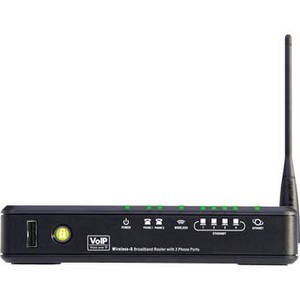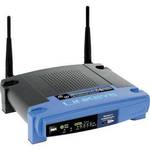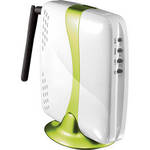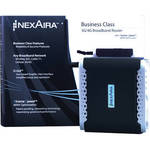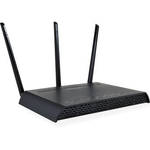Product Description
The wireless access router integrated into the Cisco WRP400 links both Wireless-G (802.11g at 54 Mbps) and Wireless-B (802.11b at 11Mbps) clients. The WRP400 also includes a built-in, 4-port, full-duplex, 10/100 Ethernet switch to connect PCs directly or to attach additional hubs and switches. A robust firewall helps protect local computers and prevents malicious attacks from outside intruders. Two telephone ports enable high-quality feature-rich VoIP service using existing analog phones.
The Cisco WRP400 helps you share your mobile broadband network connection with your colleagues using a compatible USB broadband modem when on road. At the office, the mobile broadband network can be configured on the Cisco WRP400 as an auto-failover and recovery connection if the Ethernet WAN port loses Internet connectivity.
The Cisco WRP400 Wireless-G Broadband Router with 2 Phone Ports can help provide a high-quality online experience with fault-tolerant data delivery, exceptional voice quality and continuous, uninterrupted streaming media.
| Hardware | One 10/100 802.3/u (RJ-45) WAN interface Four 10/100 802.3/u (RJ-45) LAN interfaces Integrated 802.11b/g wireless access point Two FXS RJ-11 interfaces One USB 2.0 port (support for Mobile Broadband Modem** - available separately) Reset button/restore factory defaults LEDs: Power, Internet, Ethernet, Wireless, Phone(s), WPS Power: external, 5V DC, 2A (full range switching power adapter) Wi-Fi Protected Setup (WPS) button |
| Software | Static and dynamic routing (Routing Information Protocol [RIP] 1, RIP 2) Auto failover and recovery of Ethernet WAN connection enabled with USB Mobile Broadband Modem** Multicast pass-through Denial-of-service (DoS) prevention Web based configuration VPN pass-through with IP Security (IPsec), Layer 2 Tunnelling Protocol (L2TP), and Point-to-Point Tunneling Protocol (PPTP) Event logging Dynamic Host Configuration Protocol (DHCP) server Access control lists Universal Plug and Play (UPnP) Password-protected configuration or management sessions for web access Remote management (Session Initiation Protocol [SIP] SUBSCRIBE and NOTIFY message; use NOTIFY message to reset the box remotely) and remote web management Internet Group Management Protocol (IGMP) multicast and IGMP snooping (versions 1, 2, and 3) support 802.1p prioritization QoS support Differentiated Services (DiffServ), type of service (ToS) classification Network edge (DMZ) hosting Wi-Fi Protected Access (WPA) and WPA2 Wi-Fi Multimedia (WMM) Dual service set identifiers (SSIDs) |
| Voice Features | SIP v2, RFC 3216 Sending SIP messages via User Datagram Protocol (UDP)/TCP G.711a, G.711u, G.729, G.726 codecs G.711 pass-through Echo cancellation (G.167 and G.168) Dynamic jitter buffer Simple traversal of UDP through Network Address Translation (NAT) (Serial Tunnel [STUN], RFC 3489) Session Description Protocol (SDP), RFC 2327 Real Time Protocol (RTP)/Real Time Control Protocol (RTCP) over UDP Three-way conferencing Remote firmware upgrade Dual-tone multi frequency (DTMF) tone detection and generation Voice activity detection (VAD) Silence suppression Comfort noise generation (CNG) Caller ID generation and detecting (frequency shift keying [FSK] and DTMF) Media loopback SIP Transport Layer Security (TLS) SIP channels support both UDP and TCP transport Support for 2 simultaneous T.38 or G.729 calls T.38 fax relay, including V.17, V.21, V.27ter, and V.29 and fax pass-through (pulse code modulation [PCM}) T.38 support is dependent on fax machine and network/transport resilience Voice algorithms G.711 (a-law and µ-law) G.726 (16/24/32/40 kbps) G.729 AB G.723.1 (6.3 kbps, 5.3 kbps) Call forwarding: no answer/busy/unconditional Support for 2 simultaneous calls SIP TLS Call transfer Call waiting/hold/retrieve Three-way conferencing Call ID number and name (primary line and on call waiting) Call ID block (prevents sending out the caller ID) Anonymous call blocking Distinctive ringing Do not disturb setting Repeat dialing on busy Call return Emergency call support Dial plan Speed dial Auto-attendant Multiroom meet-me conference In-band/SIP-INFO DTMF translation |
| Data Networking | MAC address (IEEE 802.3) IPv4 (RFC 791) upgradable to v6 (RFC 1883) Address Resolution Protocol (ARP) DNS A record (RFC 1706), SRV record (RFC 2782) DHCP client (RFC 2131) DHCP server (RFC 2131) Point-to-Point Protocol over Ethernet (PPPoE) client (RFC 2516) Internet Control Message Protocol (ICMP) (RFC 792) TCP (RFC 793) UDP (RFC 768) RTP (RFC 1889, RFC 1890) RTCP (RFC 1889) Trivial File Transfer Protocol (TFTP) Real Time Streaming Protocol (RTSP) HTTP NAT (RFC 1631) Reverse NAT SDP Simple Network Time Protocol (SNTP) (RFC 2030) ToS (RFC 791, RFC 1349) QoS: packet prioritization by type Router or bridge mode of operation MAC address cloning Port forwarding IP multicast/IGMP versions 1, 2, and 3/IGMP proxy |
| Administration and Maintenance | Web browser administration and configuration via integral web server Telephone keypad configuration with interactive voice prompts Automated provisioning and upgrade via HTTP, TFTP, HTTPS Asynchronous notification of upgrade availability via NOTIFY Nonintrusive in-service upgrades Report generation and event logging Stats in BYE message Syslog and debug server records Per line and purpose configurable syslog and debug options |
| Physical Interfaces | Four 100BASE-T RJ-45 Ethernet ports (IEEE 802.3) Two RJ-11 FXS phone ports-for analog circuit telephone devices One USB 2.0 port |
| Buttons | Reset, WPS |
| Subscriber Line Interface Circuit | Ring voltage: 40 to 90 Vpk Ring frequency: 20 to 25 Hz Ring waveform: Trapezoidal with 1.2 to 1.6 crest factor Maximum ringer load: 3 ringer equivalence numbers (RENs) On-hook/off-hook characteristics: On-hook voltage (tip/ring): - 46 to -56V Off-hook current: 18 to 20 mA Terminating impedance: 600 ohm resistive 270 ohm + 750 ohm//150 nF complex impedance Frequency response: 300 to 3400 Hz |
| Regulatory Compliance | FCC (Part 15 Class B), CE, ICES-003, RoHS |
| Number of Antennas | 1 |
| Connector Type | Fixed |
| Detachable Input Panels | No |
| RF Power | (effective isotropic radiated power [EIRP]) in dBm: (Average, not including antenna) • 802.11g: typ. 18 dBm at normal temperature range (with PA) • 802.11b: typ. 20 dBm at normal temperature range (with PA) |
| Antenna Gain | 2 dBi |
| UPnP | UPnP able/certified: Yes |
| Power Supply | • Switching type (100-240V) automatic • DC input voltage: +5V DC at 2.0A max. • Power consumption: 7.9W (average) • Power adapter: 100-240V 50-60 Hz (26-34 VA) AC input, 1.8m cord |
| Indicator Lights | Power, Ethernet, Wireless, Phone 1, Phone 2, Internet, WPS |
| Security | • Password-protected configuration for web access • DoS prevention • URL filtering and keyword, Java, ActiveX, proxy, cookie blocking • VPN pass-through for IPsec, PPTP, and L2TP protocols • 64- and 128-bit Wired Equivalent Privacy (WEP) with pass-phrase WEP key generation • SSID broadcast disable • Access restriction by MAC and IP addresses • WPS, WPA, WPA2 Security Key Bits: 64, 128 |
| Operating Temperature | 32 to 104°F (0 to 40°C) |
| Storage Temperature | -4 to 158°F (-20 to 70°C) |
| Operating Humidity | 0 to 85%, relative humidity, non condensing |
| Storage Humidity | 5 to 90%, non condensing |
| Dimension (DxWxH) | 1.06 x 5.51 x 5.51" (2.7 x 14.0 x 14.0 cm) |
| Weight | 10.05 oz (285 g) |

